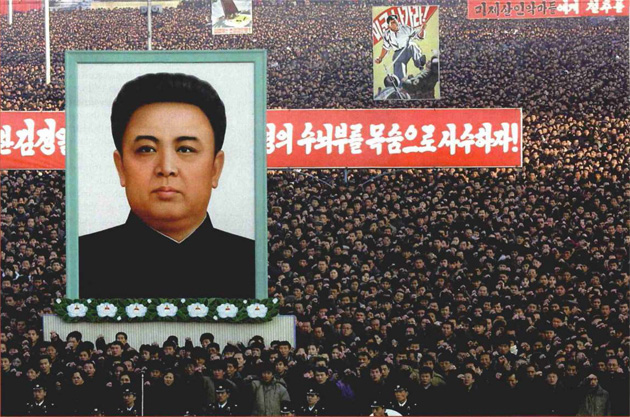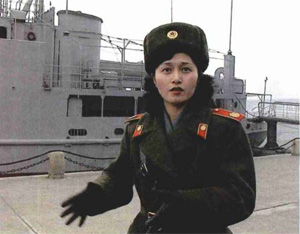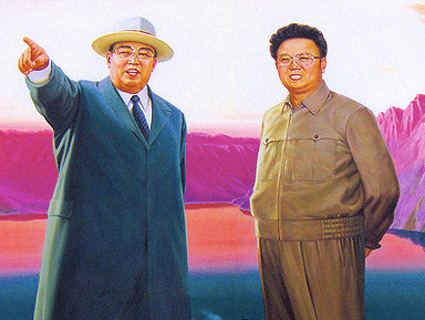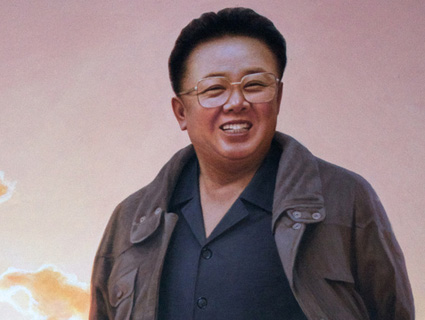 North Korea’s Kim Il Sum Square, home to mass rallies and air raid drills designed to prepared the populace for a nuclear war with the United States. NewscomUpdate: North Korean dictator Kim Jong Il died on December 17, 2011. This piece illustrates the challenges facing a country gripped by a cult of personality once that personality has left the stage.
North Korea’s Kim Il Sum Square, home to mass rallies and air raid drills designed to prepared the populace for a nuclear war with the United States. NewscomUpdate: North Korean dictator Kim Jong Il died on December 17, 2011. This piece illustrates the challenges facing a country gripped by a cult of personality once that personality has left the stage.
The dress rehearsal for the Korean apocalypse begins at 10 a.m. sharp in Kim Il Sung Square with a terrifying wail of sirens that sends Pyongyang’s citizens fleeing for cover. Fraught-looking women and cloth-capped workers break into a run, and I watch as they race across the broad square, down misty streets, and into the bowels of the subway. Once the square has emptied, the warnings are replaced by the rousing strains of martial music assuring the masses huddled underground of the ultimate victory of the fatherland.
Air-raid drills are a fact of life in Pyongyang, along with scheduled blackouts that plunge this city of 2 million into an eerie darkness through which even the trams ghost along without lights. This may be the most militarized nation on earth, but people here believe the nuclear threat comes from the outside. “The Americans were the first to threaten a preemptive nuclear strike,” says my guide, O Jin Myong, as he leads me through the cavernous subway passages decorated with enormous glass chandeliers, Romanesque arches, and huge murals extolling the country’s founder, Kim Il Sung. The platforms, carved more than 100 yards underground, will serve as shelters in an attack, Mr. O tells me. “Here the American bombs can’t get us.”
At first, the talk of nuclear bombs and first strikes sounds premature, even paranoid. But during my weeklong visit to the world’s most isolated nation last February, I hear this mantra so many times that it takes on a logic of its own. “Tell the world we are not afraid of nuclear weapons,” says an elderly female guide, Ri Ok Hi, after finishing up a tour of a monument to the Workers Party. “We will fight to the death for our leader.”
As one of the first Western journalists allowed in since North Korea’s latest nuclear crisis with the United States began last fall, I experience firsthand the paranoia that marks everyday life for North Koreans. For seven days, I am watched, followed, and fed propaganda. From doctors to parsons, everyone I am introduced to—and I have no choice about whom I meet—parrots the same line: hatred of the Americans, matched only by their love of the “Great Leader,” Kim Jong Il.
Reverence for the Kim family reaches its zenith at Mangyongdae, birthplace of Kim Il Sung, to which all North Koreans are expected to make a pilgrimage at least once in their lifetime. Amid perfectly manicured lawns and hedges, lines of youth brigades, women’s groups, and peasants—all dressed in the North Korean equivalent of “Sunday best”—line up to pay homage at the pristine thatched cottages where the “Eternal General” spent his childhood.
I ask the guide, a young woman with excellent English and a petal-pink coat, what she thinks of the founder’s son—the current leader, Kim Jong Il. Taken aback at such an ignorant question, she laughs. “He is my father, also our father,” she says, then reverentially points out water jugs from which the elder Kim drank and the mats on which he slept.
A visit to the humble origins of the ruling dynasty is supposed to remind North Koreans how far their nation has progressed under revolutionary leadership. But once out of the showcase gardens and back on the streets of Pyongyang, it is clear that the country, which once styled itself a “workers paradise,” is—in material terms at least—regressing.
Only the most privileged 5 percent of the population—the Workers Party cadres, government apparatchiks, and military brass who run the country—are allowed to live in Pyongyang, which is supposed to be a glittering example of the regime’s centralized planning. Thirty years ago, during North Korea’s economic heyday, that might have been true. It’s still an impressively laid-out city, blending modernist functionality and the green curved roofs of traditional Korean architecture. From every major building, huge images of Kim Il Sung and Kim Jong Il smile down benevolently, and slogans urge the populace to work harder or fight to the death against the American “murderers.” While we walk on the eastern bank of the frozen Taedong River, my guides point out the 164-yard-tall Tower of the Juche Idea, the most concrete symbol of the late President Kim Il Sung’s ideological contribution—juche, or self-reliance. But it has been many years since any mighty monuments were built. And even in the capital city, signs of grinding poverty appear to contradict plaudits to the great leader.
At the Grand People’s Study House, North Korea’s national library, two huge reading rooms are dedicated to the works of Kim Jong Il, including treatises on filmmaking, journalism, architecture, agriculture, and, of course, military strategy. Some are so well thumbed that the tattered pages look ready to crumble. The young librarian, Hwang Sun Ryol, insists that her country’s leader wrote 1,500 books during his university days. When I doubt that anyone could write a book a day for five years, she does not hesitate: “He is the most outstanding theoretician. No one can match his creativity and enthusiasm.” (I thank her and, in the spirit of cultural exchange, donate an anthology of George Orwell’s essays and a video of Monty Python and the Holy Grail.)
The adulation will reach its peak on February 16, the semi-religious celebration of Mr. Kim’s birth. Every year, the state-controlled media report miraculous phenomena: concentric rainbows circling the sun, the birth of a new star, and unseasonably warm temperatures at Mount Paektu, said to be the Great Leader’s birthplace (although Western historians say he was actually born in Russia). One year, an albino sea anemone was said to have trapped itself in fishing nets so that it could come ashore to celebrate. I was in Pyongyang the week before the birthday. Posters advertised a huge exhibition of thousands of Kimjongilia (Kim Jong Il flower), the bloom dearest to the heart of every North Korean. The entire nation is said to feel restless and uneasy when Mr. Kim is on one of his rare trips outside the country. No matter where he is, at night and early in the morning, Pyongyang’s streets echo with an eerie lullaby, played over loudspeakers, that asks, “Where Are You, Beloved General?”
Outside the capital, international-aid workers say that the cold and hungry people are too concerned about day-to-day survival to bother with ideology. But the state’s propagandists claim the reverse—that the country has been able to endure famine and tension only because of their love for the Great Leader. “Of course, it is a personality cult,” said Kim Myong Chol, a former writer for the People’s Daily. “But devotion to our leader is the only thing that keeps us sane. Every morning, people are told to imagine that they are Kim Jong Il. Then, they believe they are part of the most powerful nation on earth.”
Devotion to the leader is matched only by hatred of foreigners, especially Americans. The Korean peninsula was once known as the Hermit Kingdom; in some ways, juche is just a new term for historic xenophobia. From kindergarten, North Koreans are taught that the United States is evil and the reason that their country is poor, anxious, and in need of a dictatorship (no one bothers to pretend this is a democracy).
To understand why North Korea feels so threatened, I was taken to the Victorious Fatherland Liberation War Museum, where exhibits purport to show U.S. atrocities during the Korean War, including photographs of alleged massacre victims.”The United States aggressors will never diminish the spirit of our country. We are ready to sacrifice ourselves for the Great Leader Kim Jong Il,” says guide Kim Mi Jyong.
 To North Korea with love: Kim Mi Jyong proudly shows off the USS Pueblo, an American intelligence-gathering ship captured in 1968. Photo: Jonathan WattsDeadly attractive in her military uniform and ruby-red lipstick, Ms. Kim makes an unforgettable impression. I came to think of her as the smersh Lady because her looks, delivery, and utter conviction would make her the perfect enemy agent in a Bond movie. Our only skirmish, however, is over propaganda. As she taps her pointer on vials of contaminated insects and peculiarly shaped bombs—evidence, she says, that America used biological warfare during the Korean War—I tell her that in the outside world, people believe that her country also possesses biological and chemical weapons. “Is that possible?” I ask.
To North Korea with love: Kim Mi Jyong proudly shows off the USS Pueblo, an American intelligence-gathering ship captured in 1968. Photo: Jonathan WattsDeadly attractive in her military uniform and ruby-red lipstick, Ms. Kim makes an unforgettable impression. I came to think of her as the smersh Lady because her looks, delivery, and utter conviction would make her the perfect enemy agent in a Bond movie. Our only skirmish, however, is over propaganda. As she taps her pointer on vials of contaminated insects and peculiarly shaped bombs—evidence, she says, that America used biological warfare during the Korean War—I tell her that in the outside world, people believe that her country also possesses biological and chemical weapons. “Is that possible?” I ask.
“No, never. No. No,” she replies, shaking her head almost pityingly.
Ms. Kim is missionary in her zeal and utterly charming in the way she tries to open my eyes to the horrors of the American imperialist aggressors. She takes me on a tour featuring the USS Pueblo, an intelligence-gathering ship captured in 1968, and US aircraft shot down by North Korean “ladies” during the war. Conversation returns to the current tensions, and I note that a repeat of the Korean War, in which 4 million died, would mean terrible suffering for the North Korean people.
She smiles heartbreakingly. “No problem,” she replies.
Such messages of suicidal devotion are a staple of the local media. Sitting in a smoky hotel coffee shop, surrounded by aquariums, I read the Pyongyang Times and the comments attributed to Kim Kyong Ho of the Socialist Youth League: “Eight million Korean young people are fully ready to become human bullets and suicide bombs. Even if the enemy is allied to attack us, we will never be frightened. We are sure of our final victory.”
North Korea has always been fond of bellicose hyperbole, but in the last year, the United States has been unable to resist engaging it in a war of words. George W. Bush included North Korea in the “Axis of Evil” and publicly stated that he “loathed” Kim Jong Il. Pyongyang then announced in October that it had not, as it had promised in 1994, halted its nuclear-weapons program. And the bad news kept coming. North Korea reopened the Yongbyon nuclear reactor in December, kicked out international inspectors at New Year, and withdrew from the nuclear nonproliferation treaty in January—all of which renewed Western suspicions about its nuclear ambitions and sparked international condemnation.
America’s response—including cuts to vital fuel-oil supplies and food aid—seems only to have confirmed North Korea’s image of itself as a fortress being starved into submission by a malicious outside world. This siege mentality is undoubtedly useful for North Korean leaders who would otherwise have to answer difficult questions about the country’s shattered economy. Under Kim Jong Il’s “military first” policy, everything is subordinate to national defense. Pyongyang is filled with military posters, and each morning its residents wake to the sound of martial music. Primary-school children are taught songs such as “Little Tank Rushes Forward.”
But for all the tough talk, a generation of North Koreans is being physically stunted and developmentally damaged due to malnutrition—and if it is true that an army marches on its stomach, then North Korea’s military is not going to get very far. Hundreds of thousands of North Koreans are believed to have died from starvation at the end of the 1990s; a few who managed to escape into China reported that people were dropping dead in the streets. The situation was starting to improve, thanks to the World Food Program (WFP), which feeds more than a quarter of North Korea’s 22 million people: Since 1998, chronic malnutrition has fallen from 62 percent to 42 percent, while the proportion of underweight children has dropped from 61 percent to 21 percent.
But these gains are in danger of being wiped out because donations of food, fuel, and medicine have almost dried up since the start of the nuclear crisis last October. No government will admit that there is a connection between politics and humanitarian aid, but the United States—usually the biggest donor of food to the North—ceased offering food once the crisis began. (Late February, in a conciliatory gesture to South Korea, the United States resumed delivery, but at less than a third the volume it provided in 2002.) Japan, an important provider in the past, has given nothing for more than a year. Even in Europe, which is still supplying grain, it is becoming harder for governments to justify providing assistance to a country so out of step with global norms.
The WFP has thus been forced to ax support for 3 million people and reduce rations for 3.2 million of the most needy, including babies, orphans, lactating women, and the elderly. Schoolchildren must now get by on 300 grams of food a day, compared with 500 grams in the past. In South Hamgyong Province, 1 child in 2 is stunted, and 1 in 8 suffers from wasting or acute malnutrition. Nationwide, one-third of mothers are malnourished and anemic. “The crisis is not over. If the UN can’t provide more medicine and food—and quickly—we will see malnutrition rates rise again, undoing much of the progress that has been made,” warns James Morris, WFP executive director.
Weeks before I arrived in Pyongyang, I had requested a visit to hospitals and orphanages in some of the worst-affected parts of the country. And though you’d think that appealing to Western charity would serve the regime, my handlers say they are unaware of any such request. Instead, they decide I should visit the General Hospital of Koryo Medicine, a showpiece institution for traditional healing. Here I am shown remarkably healthy-looking patients in perfectly starched and ironed outfits receiving treatment by acupuncture, moxibustion, cupping, and massage.
The deputy director, Hyun Chul, a hearty fellow to whom I take an immediate dislike, boasts that the hospital—established, of course, by Kim Jong Il—helped the nation through a period of crisis when Western medicine ran out. Korean spirit, he says, is more important than physical well-being. “A lack of food and energy does not really affect our people’s health,” he says.
He leads me through dark corridors decorated with anti-American posters and some of the grotesque atrocity pictures I’d already seen at the Fatherland Liberation Museum. “Isn’t a hospital a rather odd place to be encouraging people to hate and kill each other?” I venture. Mr. Hyun doesn’t blink. “Our people are ready to fight to the last for a final victory. It doesn’t matter if you are a doctor, a teacher, or a scientist; if you are called by Kim Jong Il, you must change into an army uniform and get ready to fight.”
“How prepared are you to take up a gun?” I ask.
“I am a crack shot,” he grins. “If I fire 100 bullets, all 100 hit the target.”
Such pride may be the death of North Korea. “The situation in the northeast [part of North Korea] is worse than the Horn of Africa or Chechnya,” says one aid worker. “I have never seen children suffering so badly from malnutrition. The growth of children has been stunted to such a degree that 11-year-olds look like six-year-olds. Generations of North Koreans will be mentally retarded.”
Even in Pyongyang, people live in wretched conditions. In the winter, the temperature can dip below zero, and electricity is in such short supply that the government has closed the Children’s Palace—a cultural centerpiece—because it cannot heat the building. At the elite Kim Il Sung University, tomorrow’s diplomats and politicians are forced to study in scarves and overcoats. Even the energy ministry has no heat, and its officials say many of the city’s high-rise apartment complexes also have no power for elevators, heat, or water. “You can imagine the suffering of people who live on the 20th and 30th floor,” says Kim Myong Chol, a director of the ministry of coal and electricity industries. “The very old, the very young, and the weak are worst affected. It is an agony to our people.”
O Yong Il, external director of the Economic Promotion Committee, says shortages of electricity mean machine-tool factories are able to run at only 60 to 70 percent of capacity, and the furnaces at steel and iron works are not functioning. “It is hurting people in their daily lives,” he says. “Shops and factories are not producing the things people need.”
Under the 1994 “Agreed Framework” deal brokered by Jimmy Carter, North Korea promised to mothball its suspect nuclear plant in Yongbyon in return for two modern light-water reactors and better diplomatic and trade relations. It was, many in the Bush administration now believe, a fantastic piece of blackmail that rewarded North Korea’s “bad behavior.”
But the gloom of Pyongyang tells another side of the story. The light-water reactors were supposed to have provided 250 megawatts of power by this year, but construction is years behind schedule and now looks like it will never be completed. Until the work was finished, the United States was slated to provide 500,000 tons of fuel oil, but this was cut last November.
Blaming the United States for isolating North Korea, the electricity director, Kim Myong Chol, says that cuts to the country’s oil imports are creating serious problems, and his country plans to build five reactors that together will be capable of producing 255 megawatts of electricity.
This plan has put Pyongyang on a collision course with Washington, which suspects North Korea will use the nuclear plants to enrich uranium in order to build nuclear weapons for its army and to sell on the international market. That may be so, but North Korea’s energy needs are undeniable. Satellite pictures of Asia at night show blazing lights in Japan, South Korea, and China, but a black hole in North Korea. The streets of Pyongyang are so dark that this capital city has become the perfect place for stargazing.
The contrast with the dynamic, modern, information-rich nation south of the border could not be more striking. It is brought home to me in one of the few permitted churches, where the parson has to submit his sermons to the censors a month in advance. The day I attend happens to coincide with a rare visit by a group of choristers from Seoul. The Southerners look plump, expensively dressed, and happy—cracking jokes and taking pictures with digital cameras and video recorders. By comparison, the Northern congregation looks frail, cold, and anxious. “It was heartbreaking to see the suffering of our brothers and sisters,” says one of the Southern visitors.
On February 15, the day before Kim Jong Il’s 61st birthday, I head back to the demilitarized zone, and onward to Seoul, and from there to Tokyo, where I now live. At the only service station on the road from Pyongyang, the staff rehearses a song called “General Kim Jong Il, Please Don’t Travel the Snowy Road,” which implores their leader not to work too hard. Tomorrow, children at orphanages and hospitals will get extra rations, as will the 200,000 prisoners—about 1 percent of the population—inside the country’s brutal “re-education camps.”
Oddly, I feel more calm at the DMZ than I have all week. Here, in the border area where the North’s million-man army comes eyeball-to-eyeball with 600,000 South Korean soldiers and 37,000 US troops, tension has been the norm for so long that the nuclear crisis appears to be just another incident. “If the Americans keep on squeezing us, do you think we’ll sit back and take it?” asks Lt. Colonel Ri Gwang Hol. “If they attack us, we’ll attack America in a most unexpected way.”
But, he says, his main priority is not to mobilize for war, but to prepare for the “Great Leader’s” birthday. When the day comes, the Workers Party newspaper, Rodong Sinmun, reports the appearance of glorious rainbow clouds in the Mount Paektu range: “It seems it is the magic of heaven that on the birthday of the Great Leader, this phenomenon appears.” North Korean television hails the discovery of a rare albino raccoon, which it says signifies momentous times ahead for the country and its leader.
I leave the country the next day with a deep sense of foreboding. In a week, I’ve been taken to about a dozen places and introduced to almost 20 people, but I’ve not found a single ideological crack, not a hint that anyone wanted a different life, that a single person would flinch from death to protect the beloved general. This is, no doubt, just what my hosts want me to believe: that North Korea is a country to be feared and respected rather than loved and pitied. Certainly, after a paranoid week in Pyongyang, it seems only natural to me that Kim Jong Il would want to build nuclear plants and missiles, not despite but because of international condemnation.
And—short of a war—what could stop him? Outside pressure only strengthens the North Korean siege mentality. And internally? Well…one day, regime change might occur in North Korea, but for now it is impossible to imagine that it will ever be initiated from within. Too many people have taken part in too many birthday celebrations for too long.















